 LG Electronics’ PR department clearly don’t believe in a day of rest because Sunday saw them busily announcing the impending release of their LG PM 80, a PDA capable of receiving T-DMB (terrestrial digital multimedia broadcasting).
LG Electronics’ PR department clearly don’t believe in a day of rest because Sunday saw them busily announcing the impending release of their LG PM 80, a PDA capable of receiving T-DMB (terrestrial digital multimedia broadcasting).
The pocket-swelling, man-sized device sports a large 3.5inch QVGA LCD screen, with a claimed battery life of up to 2.5 hours of continuous viewing (fine for watching the match, but you might get unstuck if the final goes to extra time followed by penalties).
T-DMB has been described as a “promising cross between telecom and broadcasting, enabling people to enjoy crystal-clear video, CD-quality audio and data on the move via mobile handsets”, and LG is claiming that it’ll work just dandy on the move, saying that the PM 80 could provide stable reception at speeds over 100km/h.
 The actual device, presented here in the traditional manner by near-ecstatic Korean ladies (if only we got so much unbridled joy from our gadgets) follows the traditional PDA form factor, with the addition of an old-school pull out aerial for TV reception.
The actual device, presented here in the traditional manner by near-ecstatic Korean ladies (if only we got so much unbridled joy from our gadgets) follows the traditional PDA form factor, with the addition of an old-school pull out aerial for TV reception.
Users can control the channels and volume via a “5 way key” and tune into DMB with a click of DMB/PDA key.
There’s 64mb RAM and 64mb ROM internal memory onboard with a SD slot for expansion.
Powered by an Intel Bulverde 312MHz processor running MS Pocket PC 2003 OS, the PM 80 can connect to a PC, allowing users to manage their e-mail lists, schedules or phone book.
 As ever, the Koreans will get to play with this device for ages before we even get a peek at it – if they don’t decide to keep it to themselves for ever, of course.
As ever, the Koreans will get to play with this device for ages before we even get a peek at it – if they don’t decide to keep it to themselves for ever, of course.
And then there’s the usual compatibility problems, the lack of available spectrum in the UK, our ‘Luddite‘ approach to the technology…[moan]….[grumble]…
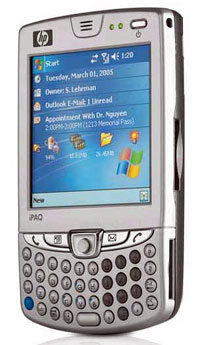 Helped by big European growth, global PDA (personal digital assistant) shipments whizzed up 21% in the third quarter of 2005, according to analysts Gartner.
Helped by big European growth, global PDA (personal digital assistant) shipments whizzed up 21% in the third quarter of 2005, according to analysts Gartner. The biggest shipment rise was recorded by Research in Motion’s (RIM) Blackberry device, growing 52.6% in the third quarter as the company extended its lead as the top dog worldwide PDA vendor.
The biggest shipment rise was recorded by Research in Motion’s (RIM) Blackberry device, growing 52.6% in the third quarter as the company extended its lead as the top dog worldwide PDA vendor.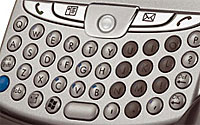 Overall, the Western European PDA market grew 53.4% in the third quarter of 2005, with 1.2 million units shipped.
Overall, the Western European PDA market grew 53.4% in the third quarter of 2005, with 1.2 million units shipped. Fujitsu Siemens have launched the “first handhelds with fully integrated GPS functionality”, the Pocket LOOX N500 and Pocket LOOX N520 PDAs.
Fujitsu Siemens have launched the “first handhelds with fully integrated GPS functionality”, the Pocket LOOX N500 and Pocket LOOX N520 PDAs.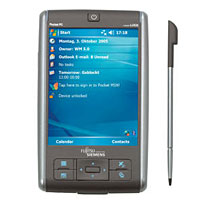 Powered by an Intel XScale PXA270 312 MHz CPU, the devices come with a SD/MMC slot (with support for SDIO), USB 1.1, IrDA and Bluetooth, with the Pocket LOOX N520 offering integrated wireless LAN 802.11g Wi-Fi.
Powered by an Intel XScale PXA270 312 MHz CPU, the devices come with a SD/MMC slot (with support for SDIO), USB 1.1, IrDA and Bluetooth, with the Pocket LOOX N520 offering integrated wireless LAN 802.11g Wi-Fi.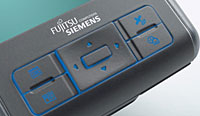 There’s also a ton of Fujitsu Siemens-branded applications bundled in the package, including Voice recorder, AudioPath and Key Look, along with a Microsoft Mobile suite including Excel, Power Point, Outlook and Internet Explorer.
There’s also a ton of Fujitsu Siemens-branded applications bundled in the package, including Voice recorder, AudioPath and Key Look, along with a Microsoft Mobile suite including Excel, Power Point, Outlook and Internet Explorer.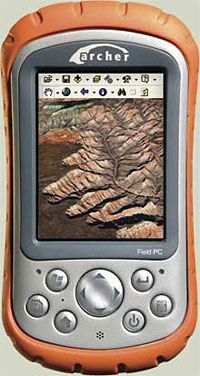 Hardcore outdoor types with lantern jaws will be whooping in their Goretex trews at the prospect of getting their hands on the new rugged Archer Field PC Pocket PC by Juniper Systems.
Hardcore outdoor types with lantern jaws will be whooping in their Goretex trews at the prospect of getting their hands on the new rugged Archer Field PC Pocket PC by Juniper Systems. Also bundled in the package is Microsoft ActiveSync 4.0, Terminal Services Client, Microsoft Windows Media Player 10 Mobile, MSN Messenger and Pocket Internet Explorer.
Also bundled in the package is Microsoft ActiveSync 4.0, Terminal Services Client, Microsoft Windows Media Player 10 Mobile, MSN Messenger and Pocket Internet Explorer.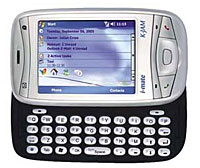 Building on the success of their hugely popular JAM phone, i-mate have announced the new K-JAM smartphone/PDA.
Building on the success of their hugely popular JAM phone, i-mate have announced the new K-JAM smartphone/PDA. The display comes in the form of a 2.8″ QVGA (240 x 320 pixels) 64k Transflective screen, and the device runs on the latest Windows Mobile 5.0 OS.
The display comes in the form of a 2.8″ QVGA (240 x 320 pixels) 64k Transflective screen, and the device runs on the latest Windows Mobile 5.0 OS.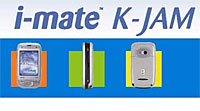 The phone offers support for a wide range of music formats, and claims 10 hours running time in PDA mode and 4-5 hours talk time.
The phone offers support for a wide range of music formats, and claims 10 hours running time in PDA mode and 4-5 hours talk time. Dell has announced three updates to its popular Axim PDA series, headed up by the powerful, VGA-enabled X51v.
Dell has announced three updates to its popular Axim PDA series, headed up by the powerful, VGA-enabled X51v.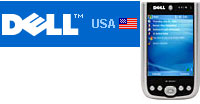 One big difference from previous models is the use of non-volatile memory, which means that the new Axim X51v uses RAM exclusively for running programs and stores all programs and data in flash.
One big difference from previous models is the use of non-volatile memory, which means that the new Axim X51v uses RAM exclusively for running programs and stores all programs and data in flash. 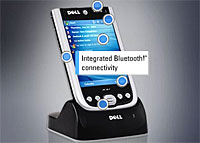 Connectivity is taken care of with integrated Bluetooth 1.2 and Wi-Fi 802.11b support, with WPA and LEAP security for the latter.
Connectivity is taken care of with integrated Bluetooth 1.2 and Wi-Fi 802.11b support, with WPA and LEAP security for the latter. 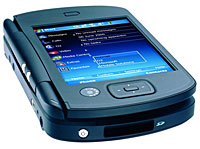 O2 has announced the launch of the o2 Xda Exec, the first PDA and mobile phone combo device to feature 3G.
O2 has announced the launch of the o2 Xda Exec, the first PDA and mobile phone combo device to feature 3G. Reflecting its business focus, the phone comes with Pocket Outlook, Word, Excel, Powerpoint and PDF viewers pre-installed and offers Bluetooth, Wireless LAN, 3G and tri-band GPRS connectivity.
Reflecting its business focus, the phone comes with Pocket Outlook, Word, Excel, Powerpoint and PDF viewers pre-installed and offers Bluetooth, Wireless LAN, 3G and tri-band GPRS connectivity. Combined with our service bundle, we believe that the O2 Xda Exec will build on the success of the Xda range, extending our market share still further into 2006.”
Combined with our service bundle, we believe that the O2 Xda Exec will build on the success of the Xda range, extending our market share still further into 2006.” Technical stuff:
Technical stuff: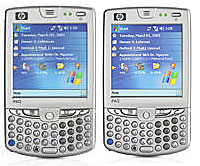 There were red faces at HP (or perhaps a wild cackle from a Machiavellian PR guru) after a video presentation on their website leaked details of their next smart-phone release, the iPaq hw6700 series.
There were red faces at HP (or perhaps a wild cackle from a Machiavellian PR guru) after a video presentation on their website leaked details of their next smart-phone release, the iPaq hw6700 series. 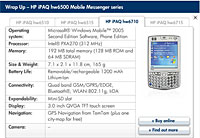 Both iPaqs come with a 3 inch, QVGA 240 x 320 pixel screen, with the handhelds measuring 7.1 x 2.1 x 11.8cm and weighing 165g. Power comes in the shape of a removable 1200mAh Lithium Ion battery
Both iPaqs come with a 3 inch, QVGA 240 x 320 pixel screen, with the handhelds measuring 7.1 x 2.1 x 11.8cm and weighing 165g. Power comes in the shape of a removable 1200mAh Lithium Ion battery 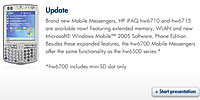 Of course, it’s always wise to be wary when information is leaked in this manner, and there is something that doesn’t quite sit right in the presentation.
Of course, it’s always wise to be wary when information is leaked in this manner, and there is something that doesn’t quite sit right in the presentation. 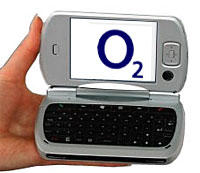 O2 is set to introduce the new Windows Xda Exec, touted as the most feature-packed smartphone ever released.
O2 is set to introduce the new Windows Xda Exec, touted as the most feature-packed smartphone ever released. 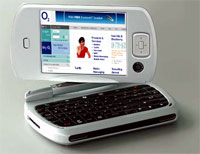 Powering the smartphone is an Intel PXA270 520MHz processor supported by 128MB ROM and 64MB RAM onboard, with expansion taken care of via a MMC/SD Card slot (supporting SDIO).
Powering the smartphone is an Intel PXA270 520MHz processor supported by 128MB ROM and 64MB RAM onboard, with expansion taken care of via a MMC/SD Card slot (supporting SDIO).  In spite of pundits’ predictions of a swift demise, the PDA refuses to die with 2005 looking set to be a record year for handheld sales.
In spite of pundits’ predictions of a swift demise, the PDA refuses to die with 2005 looking set to be a record year for handheld sales.  Like Billy Bunter at a speed eating competition, the Western European PDA market inflated by a massive 94 percent to reach 1.3 million units in the second quarter of 2005.
Like Billy Bunter at a speed eating competition, the Western European PDA market inflated by a massive 94 percent to reach 1.3 million units in the second quarter of 2005.